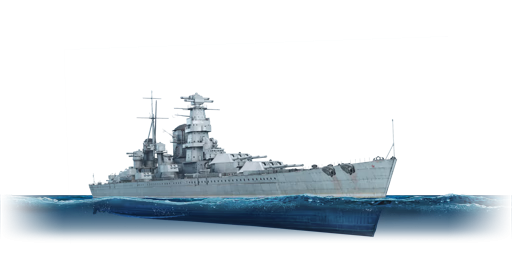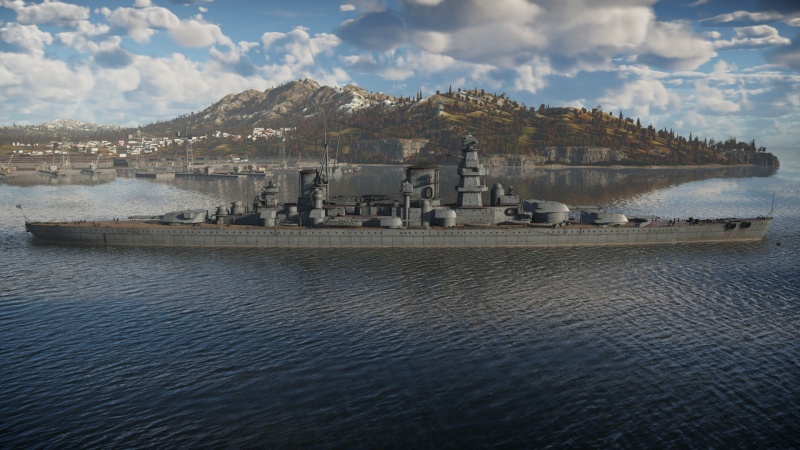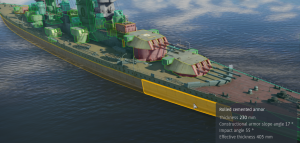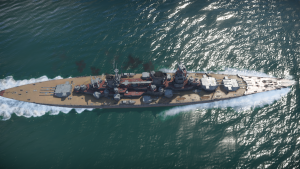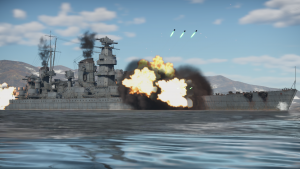Difference between revisions of "Kronshtadt"
Colok76286 (talk | contribs) |
Colok76286 (talk | contribs) (Edits) |
||
| Line 16: | Line 16: | ||
Firstly, the Kronshtadt uses an all or nothing armour scheme, wherein the vast majority of the armour is focused on the vital sections (the citadel) whilst the areas of lesser importance have little to no armour (the fore and aft). The main armour belt of the Kronshtadt is a respectable 230 mm of RCA (rolled cemented armour), covering most of the side of the hull above the waterline and extending a decent way under the waterline as well. | Firstly, the Kronshtadt uses an all or nothing armour scheme, wherein the vast majority of the armour is focused on the vital sections (the citadel) whilst the areas of lesser importance have little to no armour (the fore and aft). The main armour belt of the Kronshtadt is a respectable 230 mm of RCA (rolled cemented armour), covering most of the side of the hull above the waterline and extending a decent way under the waterline as well. | ||
| − | The bow of the ship features a 20 mm icebreaker, which can fuze penetrating shells before they hit the bulkhead, though it's only half the height of the armour belt, leaving an unprotected gap between the icebreaker and the deck. The forward bulkhead is quite thick, 330 mm of RCA. The aft bulkhead is a lesser | + | The bow of the ship features a 20 mm icebreaker, which can fuze penetrating shells before they hit the bulkhead, though it's only half the height of the armour belt, leaving an unprotected gap between the icebreaker and the deck. The forward bulkhead is quite thick, 330 mm of RCA. The aft bulkhead is a lesser 275 mm RCA, though still capable of protecting the internals. |
The deck of the citadel has three layers of armour, the first is only 14 mm, intended to fuze shells and bombs prematurely. Under this is the main armour deck, 90 mm of RHA (rolled homogeneous armour). The final layer is a 30 mm splinter deck, which tapers to 15 mm over the torpedo bulges. The deck of the fore and aft of the ship have only a single 10 mm layer. | The deck of the citadel has three layers of armour, the first is only 14 mm, intended to fuze shells and bombs prematurely. Under this is the main armour deck, 90 mm of RHA (rolled homogeneous armour). The final layer is a 30 mm splinter deck, which tapers to 15 mm over the torpedo bulges. The deck of the fore and aft of the ship have only a single 10 mm layer. | ||
| Line 39: | Line 39: | ||
{{Specs-Fleet-Mobility}} | {{Specs-Fleet-Mobility}} | ||
<!-- ''Write about the ship's mobility. Evaluate its power and manoeuvrability, rudder rerouting speed, stopping speed at full tilt, with its maximum forward and reverse speed.'' --> | <!-- ''Write about the ship's mobility. Evaluate its power and manoeuvrability, rudder rerouting speed, stopping speed at full tilt, with its maximum forward and reverse speed.'' --> | ||
| + | [[File:Kronshtadt at high speed.png|thumb|Kronshtadt at full speed]] | ||
The Kronshtadt uses 3 propeller shafts, powered by Brown Boveri steam turbines and 12x 7u-bis water-tube boilers contained in 3 engine blocks, which are ducted into two funnels, propelling the ship to an impressive maximum speed of 61 km/h (71 km/h in arcade), making the Kronshtadt a fast battlecruiser, faster than HMS Hood or IJN Haruna (57 km/h) and slightly faster than the battleship Scharnhorst (59 km/h). | The Kronshtadt uses 3 propeller shafts, powered by Brown Boveri steam turbines and 12x 7u-bis water-tube boilers contained in 3 engine blocks, which are ducted into two funnels, propelling the ship to an impressive maximum speed of 61 km/h (71 km/h in arcade), making the Kronshtadt a fast battlecruiser, faster than HMS Hood or IJN Haruna (57 km/h) and slightly faster than the battleship Scharnhorst (59 km/h). | ||
Though the vessel is extremely large, the acceleration and deceleration of the vessel is decently quick enough that you can still utilise it to dodge fire from other capital ships. | Though the vessel is extremely large, the acceleration and deceleration of the vessel is decently quick enough that you can still utilise it to dodge fire from other capital ships. | ||
| − | |||
| − | Being a long | + | Being a long and heavy ship, the 41,000 t Kronshtadt has a large turning circle and manoeuvres like a brick when stock, though the ship becomes noticeably more responsive and agile with all the mobility upgrades. The ship also tends to keel to the side somewhat when making high speed turns, especially when fully upgraded, which can thoroughly interrupt your aiming and make it physically impossible to aim at closer range targets on the side you're turning towards until you've stopped turning and recovered from the list. |
{{NavalMobility}} | {{NavalMobility}} | ||
| Line 58: | Line 58: | ||
{{main|305 mm/54 B-50 (305 mm)}} | {{main|305 mm/54 B-50 (305 mm)}} | ||
| − | The Kronshtadt is armed with a total of | + | The Kronshtadt is armed with a total of 9 x electrically powered 305 mm 54-calibre B-50 cannons, arranged in 3x large triple turrets, two superfiring fore and one aft. The ship carries 100 shells per gun, 900 in total. |
The cannons can be depressed to -3° and elevated to +45°, while the turrets can traversed at an impressive 5°/s, giving you relatively good gun handling for turrets of this size. The cannons have an average level of dispersion, not too accurate, not too spaced out. | The cannons can be depressed to -3° and elevated to +45°, while the turrets can traversed at an impressive 5°/s, giving you relatively good gun handling for turrets of this size. The cannons have an average level of dispersion, not too accurate, not too spaced out. | ||
| − | The turrets have a stock reload of 26 seconds, but can drop to 20 seconds with a max crew, which is considerably faster firing than any other ship armed with this calibre, though not quite as fast firing as the Scharnhorst with its | + | The turrets have a stock reload of 26 seconds, but can drop to 20 seconds with a max crew, which is considerably faster firing than any other ship armed with this calibre, though not quite as fast firing as the Scharnhorst with its 283 mm guns. |
Unlike other Russo/Soviet capital ships, the Kronshtadt does not have any SAP ammunition for the main turrets, having access to only two basic shell types, HE and AP. | Unlike other Russo/Soviet capital ships, the Kronshtadt does not have any SAP ammunition for the main turrets, having access to only two basic shell types, HE and AP. | ||
| − | The High Explosive shell weighs 314 kg and has an excellent level of filler, 55. | + | The High Explosive shell weighs 314 kg and has an excellent level of filler, 55.41 kg of TNT with 72 mm of explosive penetration at any angle. The muzzle velocity of the shell is 1,000 m/s, the highest of any battleship calibre shell in game, making long range aiming much easier at the expense of not being able to arc shots over the tops of islands quite as well. The HE shell is great for destroying any targets, from patrol boats up to some of the more heavily armoured cruisers and some capital ships. When fighting capital ships, the shell is very handy for knocking out unprotected crew, setting devastating fires and creating holes for flooding, which can occasionally sink enemy vessels if they don't keep on top of repairing leaks. Plus, if you strike your enemies turrets with this shell then there's a high chance you will destroy their gun barrels and cripple their firepower until they're repaired. |
| − | [[File:Kronshtadt broadside.png|thumb|Kronshtadt firing a full broadside of AP shells. ]] | + | [[File:Kronshtadt broadside.png|thumb|Kronshtadt firing a full broadside of AP shells.]] |
| − | The Armour Piercing shell weighs 470. | + | The Armour Piercing shell weighs 470.9 kg and has a bursting charge of 12.2 kg of A-IX-2, equivalent to 18.79 kg of TNT, which is a brilliant level of filler for an AP shell. For comparison, the USS Arizona (356 mm guns) has 14 kg in its AP shells and the Scharnhorst (283 mm guns) has only 7 kg. The armour penetration statistics are just as impressive, with the shell cleaving through 677 mm of armour at 1 km away and still being capable of punching past 333 mm at 15 km away. This is a comparable level of penetration to 380 mm cannons. With a fuze delay of 0.05 seconds, the shell can often pass right through soft targets like boats and destroyers, dealing little damage other than flooding, though is still useful against cruisers that have a lot of armour or that are angled toward you. The shell also has a muzzle velocity of 900 m/s which, while lower than the HE shell due to being much heavier, is still fairly fast and still allows for relatively easy aiming at long range. |
Both of these shells are of exceptional quality and together give you the capability to defeat any vessel in the game. | Both of these shells are of exceptional quality and together give you the capability to defeat any vessel in the game. | ||
Revision as of 20:41, 28 August 2022
Contents
Description
The Project 69, Kronshtadt, project is a rank VI Soviet battlecruiser with a battle rating of 7.0 (AB/RB/SB). It was introduced in Update "Danger Zone".
The project began in the mid-1930s, first envisioned as essentially a super heavy cruiser of sorts, which was first intended to be able to defeat the treaty cruisers of other major powers. Over several years, the project evolved and grew through numerous iterations to the final battlecruiser design we have in game. Unfortunately for the Soviets however, construction began in 1939, shortly before the war broke out and the vessels of the class never had a chance to leave the shipyards before the German invasion permanently halted construction, the partially completed hulls were regarded as obsolete by the war's end and scrapped shortly thereafter.
General info
Survivability and armour
Firstly, the Kronshtadt uses an all or nothing armour scheme, wherein the vast majority of the armour is focused on the vital sections (the citadel) whilst the areas of lesser importance have little to no armour (the fore and aft). The main armour belt of the Kronshtadt is a respectable 230 mm of RCA (rolled cemented armour), covering most of the side of the hull above the waterline and extending a decent way under the waterline as well.
The bow of the ship features a 20 mm icebreaker, which can fuze penetrating shells before they hit the bulkhead, though it's only half the height of the armour belt, leaving an unprotected gap between the icebreaker and the deck. The forward bulkhead is quite thick, 330 mm of RCA. The aft bulkhead is a lesser 275 mm RCA, though still capable of protecting the internals.
The deck of the citadel has three layers of armour, the first is only 14 mm, intended to fuze shells and bombs prematurely. Under this is the main armour deck, 90 mm of RHA (rolled homogeneous armour). The final layer is a 30 mm splinter deck, which tapers to 15 mm over the torpedo bulges. The deck of the fore and aft of the ship have only a single 10 mm layer.
The main turrets have sloped turret faces with 305 mm of RCA, the turret sides and roof are a uniform 125 mm RCA, the rear has the same 305 mm as the turret face, meanwhile the more vulnerable gunshields only have 152 mm of RHA. The barbettes are angular with 9 sides and have 330 mm of RCA, however once under the main armour deck the barbettes thin all the way down to 30 mm of RHA. Lastly, the turret rangefinders are covered in 30 mm splinter protection.
The bridge of the vessel is fully protected by RCA, with 330 mm and 275 mm armour plates on the front and back respectively, with 260 mm on the sides and a 125 mm roof, while the radio room below the bridge is completely enclosed in 50 mm RHA. The fire control room at the top of the superstructure also has 50 mm all around.
The secondary 152 mm turrets have 100 mm faces, 50 mm sides and roofs, and 110 mm rears, with 75 mm barbettes. The 100 mm turrets are 50 mm all around with 40 mm barbettes. The 37 mm turrets have 14 mm all around with 20 mm barbettes.
The funnels and fire directors are protected by 20 mm and 14 mm splinter protection respectively. All of the auxiliary turret and superstructure protection is made of rolled homogeneous armour (RHA).
In terms of underwater protection, the ship uses American-style torpedo bulges with 4 longitudinal bulkheads, rated to be able to absorb 250 kg of explosive weight, though the original design specifies that it should be able to withstand 500 kg. The bulges cover 61% of the ships length and have a maximum depth of 6 m, tapering to 4 m fore and aft.
Lastly, the ship has a hefty crew complement of 1,406. Though not the most by capital ship standards, this is still a more than respectable number.
Overall, the Kronshtadt is a surprisingly damage resistance ship for a battlecruiser. Though only 230 mm, the main belt can still block high calibre AP shells when angled and the belt being relatively tall and lengthy makes it excellent for blocking HE fragments. The layered armoured deck is great at resisting some of the smaller bombs and can shrug off any armour piercing shells in game except possibly at extremely long range. The turrets are reasonably sturdy, though can occasionally be knocked out by armour piercing shells hitting the relatively thin sides, however the ships ammunition doesn't tend to explode very often and the vessel can even survive one or two of the main magazines detonating. The ship in general is very HE-resistant, due to a number of factors, but mainly thanks to how the ship has a relatively small number of AA guns, which are all safe within fully enclosed turrets and covered in anti-fragmentation armour rather than being in open mounts spread across the deck. In most circumstances, the ship can practically ignore cruiser fire at anything other than short ranges and thanks to the torpedo protection, the ship is nearly immune to torpedoes which aren't strong enough to overpower your defences.
The ship is still vulnerable to other capital ships when not angled. If you're in a duel with another battleship or battlecruiser, point the bow as much as you can toward them while being able to fire all main turrets, though if you've taken major damage you may opt to angle even further at the expense of not being able to fire your aft turret.
Mobility
The Kronshtadt uses 3 propeller shafts, powered by Brown Boveri steam turbines and 12x 7u-bis water-tube boilers contained in 3 engine blocks, which are ducted into two funnels, propelling the ship to an impressive maximum speed of 61 km/h (71 km/h in arcade), making the Kronshtadt a fast battlecruiser, faster than HMS Hood or IJN Haruna (57 km/h) and slightly faster than the battleship Scharnhorst (59 km/h).
Though the vessel is extremely large, the acceleration and deceleration of the vessel is decently quick enough that you can still utilise it to dodge fire from other capital ships.
Being a long and heavy ship, the 41,000 t Kronshtadt has a large turning circle and manoeuvres like a brick when stock, though the ship becomes noticeably more responsive and agile with all the mobility upgrades. The ship also tends to keel to the side somewhat when making high speed turns, especially when fully upgraded, which can thoroughly interrupt your aiming and make it physically impossible to aim at closer range targets on the side you're turning towards until you've stopped turning and recovered from the list.
| Mobility Characteristics | |||
|---|---|---|---|
| Game Mode | Upgrade Status | Maximum Speed (km/h) | |
| Forward | Reverse | ||
| AB | |||
| Upgraded | 71 | 34 | |
| RB/SB | |||
| Upgraded | 61 | 29 | |
Modifications and economy
Armament
Primary armament
The Kronshtadt is armed with a total of 9 x electrically powered 305 mm 54-calibre B-50 cannons, arranged in 3x large triple turrets, two superfiring fore and one aft. The ship carries 100 shells per gun, 900 in total.
The cannons can be depressed to -3° and elevated to +45°, while the turrets can traversed at an impressive 5°/s, giving you relatively good gun handling for turrets of this size. The cannons have an average level of dispersion, not too accurate, not too spaced out.
The turrets have a stock reload of 26 seconds, but can drop to 20 seconds with a max crew, which is considerably faster firing than any other ship armed with this calibre, though not quite as fast firing as the Scharnhorst with its 283 mm guns.
Unlike other Russo/Soviet capital ships, the Kronshtadt does not have any SAP ammunition for the main turrets, having access to only two basic shell types, HE and AP.
The High Explosive shell weighs 314 kg and has an excellent level of filler, 55.41 kg of TNT with 72 mm of explosive penetration at any angle. The muzzle velocity of the shell is 1,000 m/s, the highest of any battleship calibre shell in game, making long range aiming much easier at the expense of not being able to arc shots over the tops of islands quite as well. The HE shell is great for destroying any targets, from patrol boats up to some of the more heavily armoured cruisers and some capital ships. When fighting capital ships, the shell is very handy for knocking out unprotected crew, setting devastating fires and creating holes for flooding, which can occasionally sink enemy vessels if they don't keep on top of repairing leaks. Plus, if you strike your enemies turrets with this shell then there's a high chance you will destroy their gun barrels and cripple their firepower until they're repaired.
The Armour Piercing shell weighs 470.9 kg and has a bursting charge of 12.2 kg of A-IX-2, equivalent to 18.79 kg of TNT, which is a brilliant level of filler for an AP shell. For comparison, the USS Arizona (356 mm guns) has 14 kg in its AP shells and the Scharnhorst (283 mm guns) has only 7 kg. The armour penetration statistics are just as impressive, with the shell cleaving through 677 mm of armour at 1 km away and still being capable of punching past 333 mm at 15 km away. This is a comparable level of penetration to 380 mm cannons. With a fuze delay of 0.05 seconds, the shell can often pass right through soft targets like boats and destroyers, dealing little damage other than flooding, though is still useful against cruisers that have a lot of armour or that are angled toward you. The shell also has a muzzle velocity of 900 m/s which, while lower than the HE shell due to being much heavier, is still fairly fast and still allows for relatively easy aiming at long range.
Both of these shells are of exceptional quality and together give you the capability to defeat any vessel in the game.
Secondary armament
Some ships are fitted with weapons of various calibres. Secondary armaments are defined as weapons chosen with the control Select secondary weapon. Evaluate the secondary armaments and give advice on how to use them. Describe the ammunition available for the secondary armament. Provide recommendations on how to use them and which ammunition to choose. Remember that any anti-air armament, even heavy calibre weapons, belong in the next section. If there is no secondary armament, remove this section.
Anti-aircraft armament
An important part of the ship's armament responsible for air defence. Anti-aircraft armament is defined by the weapon chosen with the control Select anti-aircraft weapons. Talk about the ship's anti-air cannons and machine guns, the number of guns and their positions, their effective range, and about their overall effectiveness – including against surface targets. If there are no anti-aircraft armaments, remove this section.
Scout plane
Usage in battles
Describe the technique of using this ship, the characteristics of her use in a team and tips on strategy. Abstain from writing an entire guide – don't try to provide a single point of view, but give the reader food for thought. Talk about the most dangerous opponents for this vehicle and provide recommendations on fighting them. If necessary, note the specifics of playing with this vehicle in various modes (AB, RB, SB).
Pros and cons
Summarise and briefly evaluate the vehicle in terms of its characteristics and combat effectiveness. Mark its pros and cons in the bulleted list. Try not to use more than 6 points for each of the characteristics. Avoid using categorical definitions such as "bad", "good" and the like - use substitutions with softer forms such as "inadequate" and "effective".
Pros:
Cons:
History
Devblog
During the 1930s Soviet shipbuilders were intensely working on designing new warships for the Soviet Navy. Among the top priorities was the development of a new cruiser design that could counter 10,000-ton cruisers of other nations. Several design proposals were submitted by 1935, of which none passed initial approval. The navy requested a new design, but the signing of a naval agreement with Great Britain in 1937 caused the requirements to collide with another similar project, ultimately resulting in this effort to also be canceled shortly afterwards.
Nonetheless, the Navy still sought to construct a fast and strong counter to other nations’ cruisers, resulting in the development of the Project 69 battlecruiser. However, the already modified requirements for a 26,200-ton vessel proved to be insufficient after the Soviet Navy found out about the specifications of the German Scharnhost class of battleships. This led to yet another update to the requirements in July 1938, now calling for an upgunned and up-armored 31,000-ton battlecruiser (or “heavy cruiser”). After another series of revisions, the design was finally approved for construction in Summer 1939, with two ships being ordered for completion by 1943.
One of the ordered ships - Kronshtadt - was laid down in Leningrad on 30th November, 1939. However, due to severe production delays, the warship was only deemed 10% completed by the time the German army launched its offensive on the USSR in June 1941. Following the invasion, all further construction work was suspended with some part of Kronshtadt being later used for fortifications around Leningrad. After the war, plans were formulated to convert the Kronshtadt into an aircraft carrier, but the design was already seen as outdated leading to the proposal being rejected. In 1947, the ultimate decision was made to dismantle and scrap the partially built hull.
Media
Excellent additions to the article would be video guides, screenshots from the game, and photos.
See also
Links to articles on the War Thunder Wiki that you think will be useful for the reader, for example:
- reference to the series of the ship;
- links to approximate analogues of other nations and research trees.
External links
| Admiralty Shipyards (Адмиралтейские верфи) | |
|---|---|
| Light Cruisers | |
| Project 68 | Zheleznyakov |
| Pr.68-bis-ZiF | Shcherbakov |
| Battlecruisers | |
| Project 69 | Kronshtadt |
| Battleships | |
| Sevastopol-class | Poltava |
| USSR battlecruisers | |
|---|---|
| Izmail-class | Izmail |
| Pr. 69 | Kronshtadt |


